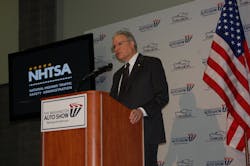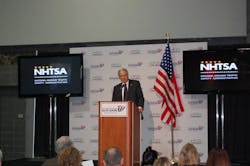WASHINGTON D.C. With roadway fatalities soaring upward “significantly” based on early 2015 data following decreases that have “flattened out” in recent years, Mark Rosekind, head of the National Highway Traffic Safety Administration (NHTSA) believes new and different initiatives are needed to reverse those trends.
“For all of the amazing success of the last few decades, it’s clear that progress on vehicle safety is slowing,” he said during a speech here at the 2016 Washington Auto Show. “There’s a big chart on the wall at the agency, charting the decrease in lives lost over the years – and that line is flattening out.”
Rosekind added that there are “too many lives at stake” to accept slow, steady, incremental progress. “We know that 32,675 people died on out roads in 2014 [and] we will not be satisfied until that number is zero,” he stressed. “But at the current pace, it will take us decades to get there.”
More troubling to Rosekind is the sharp 8.1% spike in highway fatalities that occurred over the first six months of 2015 in comparison to the same period in 2014 – meaning the fatality rate increased by 4.4% – and increase he called “horrible.”
“When our current estimates for 2015 suggest, not another year of marginal improvement, but the potential for a significant increase in highway deaths, we need to put safety at the top of the priority list,” Rosekind emphasized.
“If regulations and enforcement are out only tools to protect the public, then we are rRosekind stressed, however, that NHTSA is not giving up the use of these tools – “Anyone paying attention over the past year should know we’re not reluctant to use those tools,” he pointed out – yet indicated that “we can’t use old tools” to solve new problems.
“You are going to hear NHTSA talk a lot in the year to come about ‘proactive safety,’ about the need for all of us with a role in protecting the public to make safety out highest priority,” Rosekind explained. “Doing so will require new ways of thinking for NHTSA, automakers, suppliers, dealers, safety advocates, and the public.”
For example, he pointed to the proactive safety principles agreement recently hammered out between the U.S. Department of Transportation and 18 automakers as one step in that direction.
“We can put systems in place where industry and government collaborate to identify and address safety problems when both industry and government have safety as their primary goal,” Rosekind noted.
“What we are trying to do is change the conversation on safety from one in which we are reacting to issues after they appear to one in which we are catching them sooner or preventing them from happening at all.”
About the Author
Sean Kilcarr
Editor in Chief
Sean Kilcarr is a former longtime FleetOwner senior editor who wrote for the publication from 2000 to 2018. He served as editor-in-chief from 2017 to 2018.

